Authentic German Rouladen
This post may contain affiliate links. See my disclosure policy.
One of Germany’s most famous and delicious dishes, Rouladen (Rinderrouladen) are beef roulades filled with bacon, onions, mustard and pickles, then browned and simmered in the richest gravy imaginable. Mouthwateringly delicious and made the way my Mutti and Oma made it, this authentic Rouladen recipe is the only one you’ll ever need!
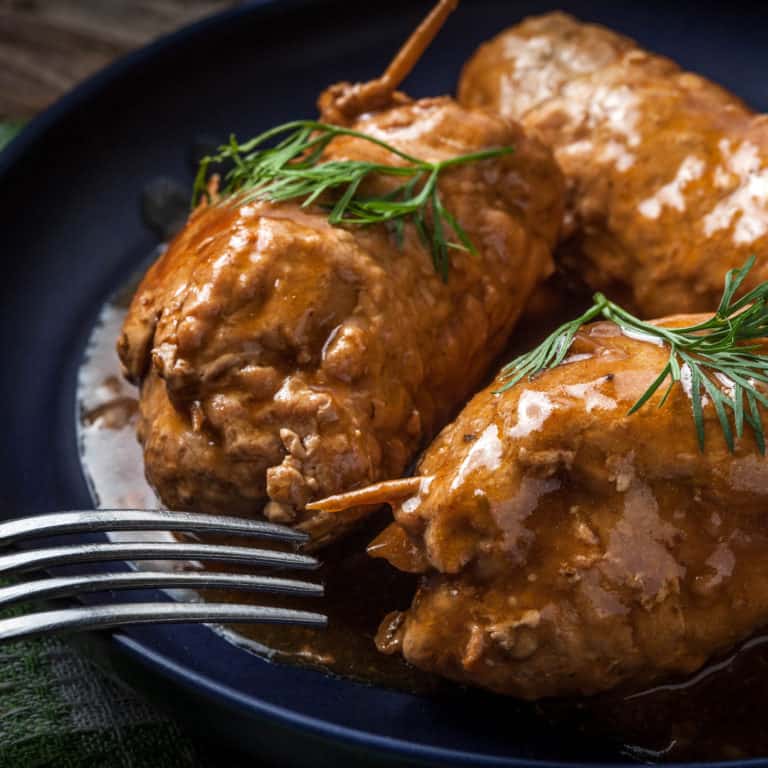
Growing up in Stuttgart, we regularly enjoyed family dinners with my Oma and Opa. My Oma was famous for her Kasseler, Kartoffelpuffer, Sauerbraten and her Rouladen. When a meal included gravy she always knew to make extra when we came over because I would heap copious amounts of it over my meat, potatoes, Semmelknödel, Kartoffelklöße, Rotkohl, Sauerkraut, you name it. (I still do.) For me the gravy was one of the primary highlights of the meal. Rouladen is one of my all-time favorite German dishes and its accompanying gravy is arguably the king of all gravies. Today I’m sharing my homemade Rouladen recipe with you and I’m confident you’re going to love it as much as we do!
What is Rouladen?
Rouladen is a traditional German dish featuring long, thin strips of meat slathered with mustard and filled with bacon, onions, and pickles. The filling is enclosed by rolling up the meat strips and the roulades are then browned and slow-simmered in a rich gravy.
Beef rouladen are enjoyed throughout the year in Germany but are often associated with Sunday dinners and special occasions like Christmas Eve.
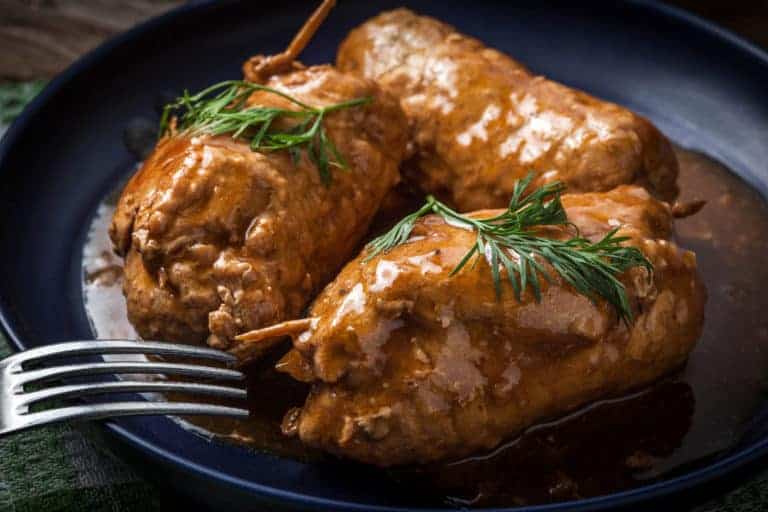
Can Rouladen Be Made Ahead Of Time?
You can save time by assembling the rouladen in advance and chilling them until you’re ready to cook them. They are also good reheated.
How Large Should the Slices of Beef Be?
They need to be large enough to stuff and roll up, at least 4×6 inches in size and about 1/4 inch thick. This recipe makes 2 rouladen per person. Alternatively you can make larger rouladen and serve one large rouladen per person.
Authentic Rouladen Recipe
Rouladen aren’t hard to make, but they do take time. You can shave off some time on the day of your meal by assembling the rouladen ahead of time and chilling them until you’re ready to cook them.
Rouladen are made by spreading some German mustard on thinly cut slices of beef, adding bacon, sliced German pickles and chopped onions. Sprinkle with some salt and pepper and roll them up, securing the rolls with toothpicks or cooking twine. Next you generously fry the rouladen in oil until they’re nicely browned on all sides. They’re then removed and set aside so you can saute the onions and vegetables for the gravy. Add the liquids and spices to the cooked veggies and nestle the rouladen in this mixture to simmer on low until the meat is fork tender. The rouladen are removed, the sauce is poured through a strainer, and the resulting gravy is returned to the pot and thickened. The rouladen are returned to the gravy, heated through and served with Rotkohl and boiled potatoes, Knödel, or Spätzle.
Below I’ve provided step-by-step pictured instructions to ensure your success!
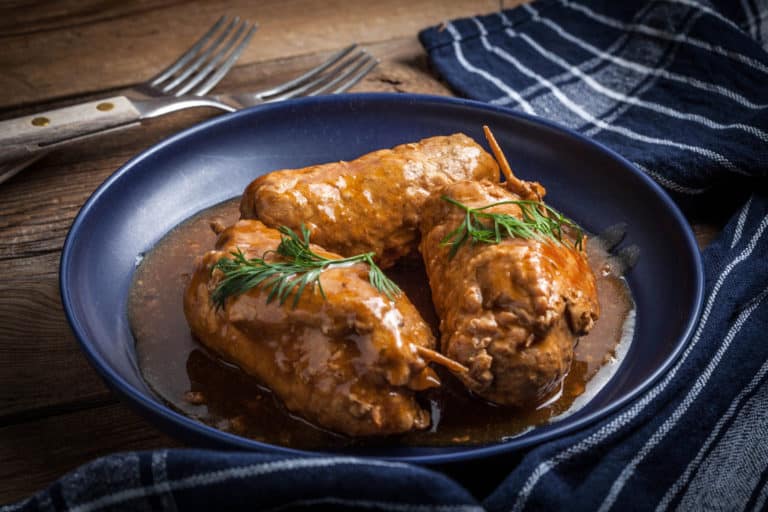
Lay the beef slices out on a work surface. Spread each beef slices with about 2 teaspoons of German mustard and sprinkle with a little salt and freshly ground black pepper.
Place a strip of bacon on each beef slice so it’s running the same length as the beef. Place the sliced German pickles and chopped onions on each beef slice.
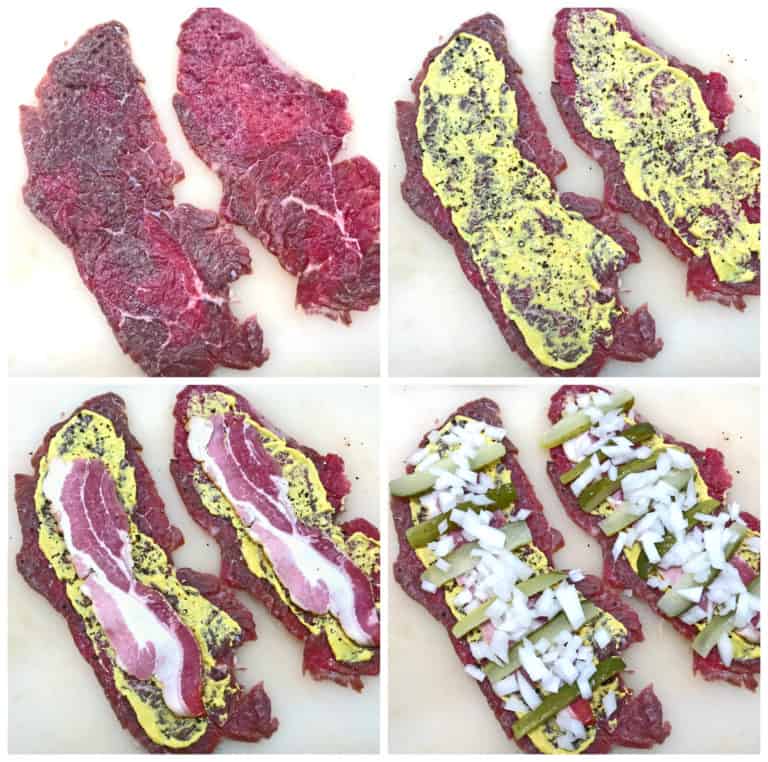
Roll up the beef slices, tucking in the sides as best you can and securing the beef rolls with toothpicks or cooking twine.

Heat the butter and oil in a heavy Dutch oven or pot (make sure it’s oven-safe if baking in the oven) and generously brown the rouladen on all sides. Browning them well will ensure a rich and flavorful gravy. Set the rouladen aside on a plate.
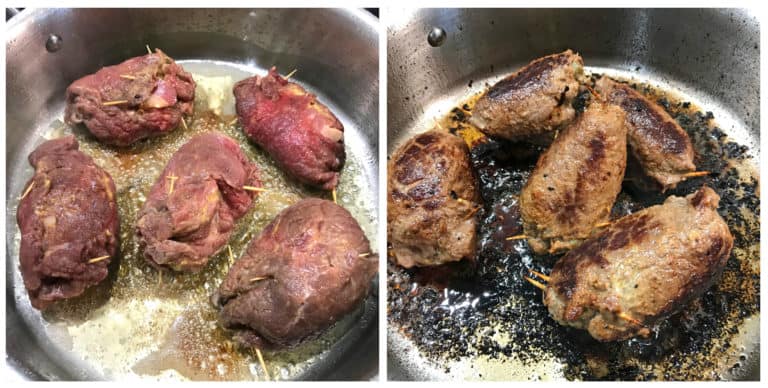
*Do not remove the browned bits in the bottom of the pan, it’s key to the most flavorful gravy!
Add the onions to the pot and a little more butter or oil if needed. Cook the onions until softened and translucent, about 5 minutes. Add the garlic and cook for another minute. Add the leek, carrots and celery and cook for another 5 minutes. Pour in the red wine, bring to a rapid boil for one minute, reduce the heat to medium and simmer for 2-3 more minutes.
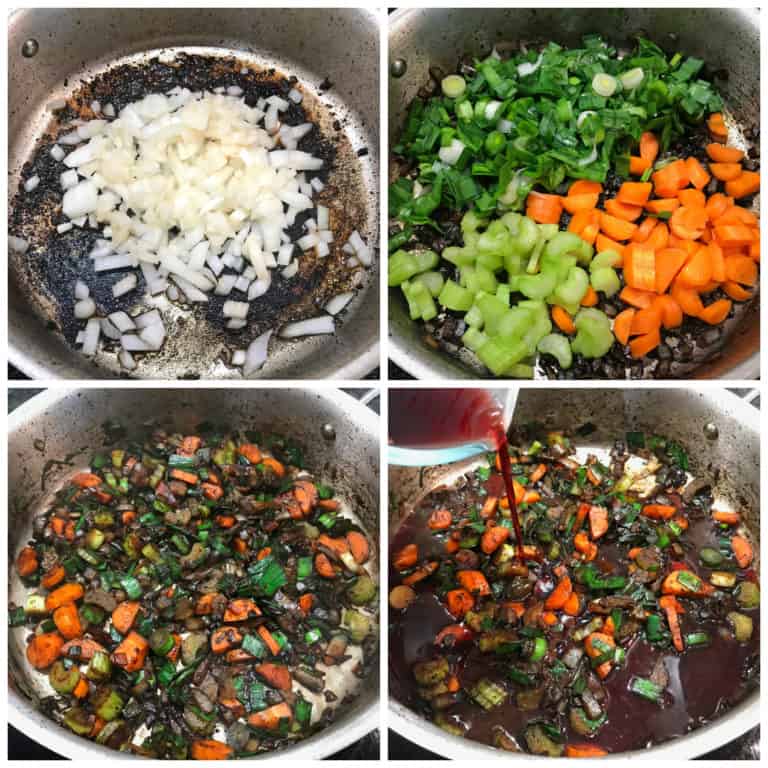
Add the beef broth, tomato paste, bay leaf, salt and pepper.
Nestle the rouladen in the pot.
Oven or Stovetop: You can cook the rouladen, covered, on the stovetop on low for about 90 minutes or until fork tender but for the most even cooking we recommend transferring the pot (make sure it’s oven-safe) to the oven preheated to 325 F and cook it there for about 90 minutes or until fork tender.
To Make the Rouladen Gravy:
When the beef is fork tender, remove the rouladen from the pot and set aside. Pour the liquid and vegetables through a strainer and reserve the liquid. (You can set the veggies aside for another purpose, they are yummy. Or you can puree the veggies in the blender and then return them to the gravy.)
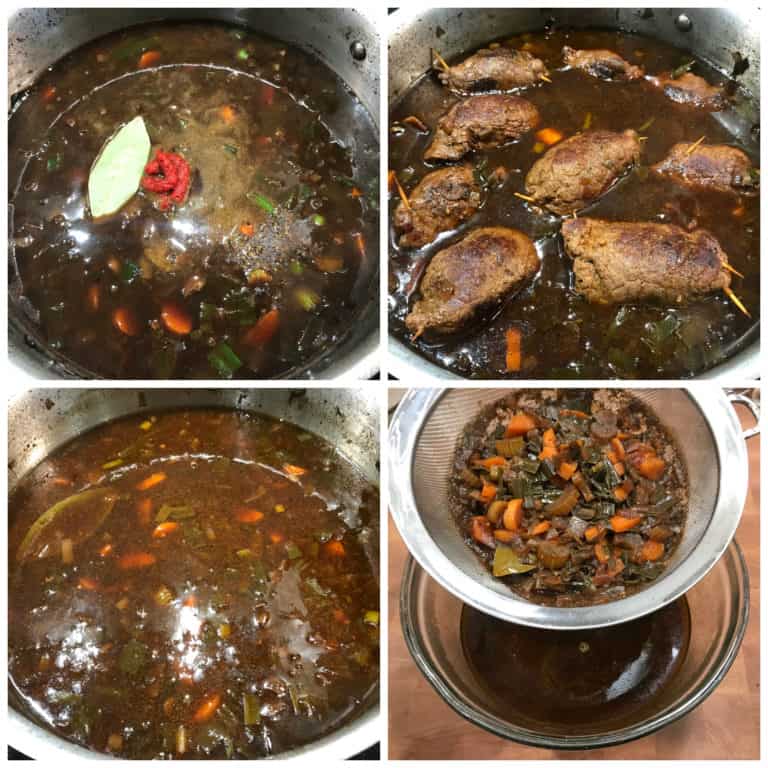
Return the strained liquid back to the pot and bring to a simmer. Thicken the gravy either with either a cornstarch slurry (for a clear/translucent gravy) or flour slurry (for an opaque gravy). For a creamy gravy you can also add a few tablespoons of heavy cream at this point. Simmer, whisking constantly, until the gravy is thickened.
Add the chilled butter, whisking constantly, until the butter is melted and incorporated. Add salt, pepper and mustard to taste. Note: If you’d like creamy gravy you can stir in some heavy cream at this point.
Carefully remove the toothpicks or cooking twine from the rouladen and return them to the gravy and heat through.
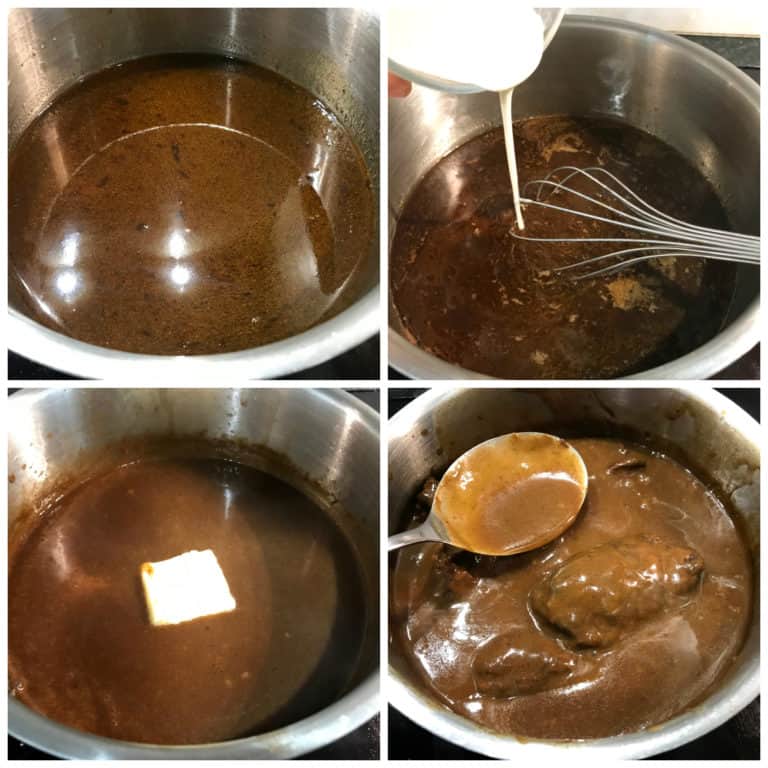
Serve the Rouladen with Rotkohl and either boiled potatoes, Semmelknödel (bread dumplings) or Kartoffelklöße (potato dumplings) or Spätzle.
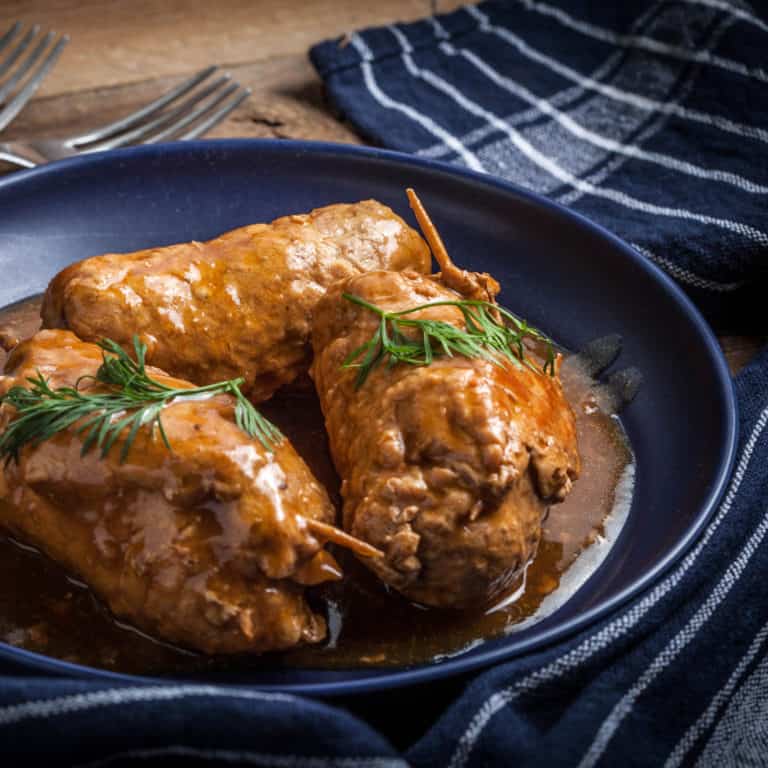
What to Serve With Rouladen
Here are some traditional German sides you can pair with your Rinderrouladen:
- Rotkohl (German Red Cabbage)
- Spätzle (German Noodles)
- Semmelknödel (German Bread Dumplings)
- Kartoffelklöße (German Potato Dumplings)
- Kartoffelpuffer (German Potato Pancakes)
- German Potato Salad (Kartoffelsalat)
- Creamy German Cucumber Salad (Gurkensalat)
- Bohnensalat (German Green Bean Salad)
- German Carrot Salad (Karottensalat)

For more authentic German dishes, be sure to also try my:
- Sauerbraten
- Königsberger Klopse
- Käsespätzle
- German Potato Salad
- Senfbraten
- Schnitzel
- Jägerschnitzel
- Schweinshaxe
- Maultaschen
- German Potato Soup
- Frikadellen
Save This Recipe
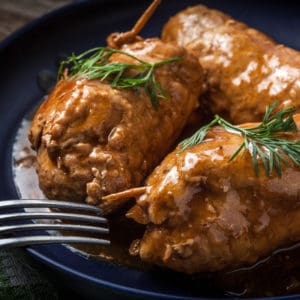
Authentic German Rouladen
Equipment
Ingredients
- For the Rouladen:
- 8 slices top round beef, about 4×6 inches in size and 1/4 inch thick (*see note) (ask your butcher), gently pound the slices with a meat mallet until they're a little thinner than 1/4 inch (be careful not to pound holes into them)
- 1/3 cup German yellow mustard
- 8 slices bacon
- 8 medium German pickles , sliced lengthwise
- 1 medium yellow onion , chopped
- salt and freshly ground black pepper
- For the Gravy:
- 1 tablespoon butter
- 1 tablespoon cooking oil (I use avocado oil because it's ideal for high heat)
- 1 medium yellow onion , chopped
- 1 clove garlic , minced
- 1 small leek , chopped, rinsed and drained in colander
- 1 large carrot , chopped
- 1 large celery stalk , chopped
- 1 cup dry red wine
- 2 cups strong beef broth
- 1 tablespoon tomato paste
- 1 bay leaf
- 1 teaspoon sugar
- 1/2 teaspoon salt
- 1/4 teaspoon freshly ground black pepper
- 4 tablespoons chilled butter
- cornstarch or flour dissolved in a little water for thickening (depending on how much gravy liquid there is you'll need about 1-2 tablespoons of cornstarch dissolved in 2-3 tablespoons of water or 2-3 tablespoons flour dissolved in 1/4 – 1/3 cup water)
Instructions
- Lay the beef slices out on a work surface. Spread each beef slices with about 2 teaspoons of mustard and sprinkle with a little salt and freshly ground black pepper. Place a strip of bacon on each beef slice so it's running the same length as the beef. Place the sliced German pickles and chopped onions on each beef slice. Roll up the beef slices, tucking in the sides as best you can and securing the beef rolls with toothpicks or cooking twine.
- Heat the butter and oil in a heavy Dutch oven or pot (make sure it's oven-safe if baking in the oven) and generously brown the rouladen on all sides. Browning them well will ensure a rich and flavorful gravy. Set the rouladen aside on a plate.
- *Do not remove the browned bits in the bottom of the pan (important for a flavorful gravy): Add the onions to the pot and a little more butter or oil if needed. Cook the onions until softened and translucent, about 5 minutes. Add the garlic and cook for another minute. Add the leek, carrots and celery and cook for another 5 minutes. Pour in the red wine, bring to a rapid boil for one minute, reduce the heat to medium and simmer for 2-3 more minutes. Add the beef broth, tomato paste, bay leaf, sugar, salt and pepper.
- Nestle the beef rouladen in the pot. Oven or Stovetop: You can cook the rouladen, covered, on the stovetop on low for about 90 minutes or until fork tender, but for the most even cooking we recommend transferring the pot (make sure it's oven-safe) to the oven preheated to 325 F and cook it there for about 90 minutes or until fork tender.
- To Make the Rouladen Gravy:When the beef is fork tender, remove the rouladen from the pot and set aside. Pour the liquid and vegetables through a strainer and reserve the liquid. (You can eat the veggies on the side or puree them in the blender and then return them to the gravy.) Return the strained liquid back to the pot and bring to a simmer. Thicken the gravy either with either a cornstarch slurry (for a clear/translucent gravy) or flour slurry (for an opaque gravy). For a creamy gravy you can also add a few tablespoons of heavy cream at this point. Simmer, whisking constantly, until the gravy is thickened.Add the chilled butter, whisking constantly, until the butter is melted and incorporated. Add salt, pepper and mustard to taste. Note: If you prefer a creamy gravy you can stir in some heavy cream.Carefully remove the toothpicks or cooking twine from the rouladen and return them to the gravy and heat through.
- Serve the rouladen and gravy with Homemade Rotkohl and either Homemade Spätzle, Homemade SemmelKnödel (or Kartoffelknödel) or boiled potatoes.
Notes
- This recipe makes 2 rouladen per person. Alternatively you can make larger rouladen for one large rouladen per person.
Nutrition
Originally published on The Daring Gourmet October 29, 2019



















These rouladen truly are a culinary delight that combines rich flavors and hearty ingredients.
Wonderful, thank you so much, Lily!
I’ve made Rouladen all my life for special occasions like Christmas Eve (as I will be doing this year). Your recipe sounds superior to mine (especially with the mir poix simmering in the pot). Anyway, one question: What would you say is the approximate weight of each Rouladen slice (before filling and cooking). I want my butcher to have an idea of how large to make them. Thank you,
René
Hi Rene! Rouladen are a favorite for Christmas Eve in our home also <3 I have never weighed the beef slices, I just go size and thickness and you can give those measurements to the butcher: roughly 4x6 inches and 1/4 inch thick. That's kind of a standard size but can make them larger if you prefer. Any smaller though and they become a little difficult to fill and roll.
Absolutely delicious! The braised beef is incredibly tender and the sauce rich in flavour. I was lucky to grow up with this dish on special Sunday nights, but this recipe is superior to my Oma’s and Mom’s! A keeper recipe and company worthy, thanks!
What a terrific compliment, Chris, I’m thrilled that you enjoyed it and really appreciate the feedback, thank you!
Do you mean 90 minutes on stove AND 90 minutes in the oven? 180 minutes of cooking? Or either stove or oven?
Hi Rick, it’s one or the other. About 90 minutes or longer until fork tender.
This has become our traditional Christmas Eve dinner for the past 3 years and I’ll be making it again for Christmas Eve this year. These Rouladen are truly special. We look forward all year to sitting down as a family with our married children and their spouses (and two new grandchildren this year!). Thank you for helping make our Christmas Eve extra special.
Oh that warms my heart to hear that, Sonja, thank YOU so very much! <3
Oh, these Rouladen are truly a culinary delight!
I’m so glad you enjoyed them, Lily, thank you!
Your instructions say to cover the rouladen if cooking on the stove top, but if I put the rouladen in the oven, should it be covered?
Hi Cindy, yes – whether on the stovetop or in the oven it should be covered.
Here is another Stuttgart girl came to the US in 1962 still make all that good “schwaebisch ” stuff just like your recipes !
I like to fry my bacon and onions first before putting them in the rouladen .
Speatzle and Rouladen our Heiligen Abend Essen I usually make 25 of them
Ah, so nice to “meet” you, Heidi! <3 Rouladen is a favorite choice in our home for Christmas Eve as well. And then for New Years it's often Schwäbische Linsen mit Spätzle or Würstchen mit Kartoffelsalat :)
Hi Kimberly,
here’s another German chick from Memmingen :-) Raised in UK, then when I was six we moved to Germany, now living in Idaho and running a German restaurant. Thank you for your great and authentic recipes which I love to use! Weiter so, du Liebe!
Ah, Memmingen! I’ve driven through there at least a couple of times on trips down to the Bodensee <3 It's so nice to meet you Stefanie and I really appreciate the compliment, thank you! <3 I have family in Idaho and there's a German deli in Boise that I've stopped in a couple of times - is that yours??
Hi! I haven’t made roulade for many years. Am I able to make the day before and cook in the oven the day of? or should I just reheat the next day?
Hi Cori, you can do either, choose whatever is more convenient for you.
Really enjoyed these delicious homemade German Rouladen!
Thank you so much, Lily!
I really enjoyed your delicious homemade German Rouladen!
Thank you so much, Lily!
This was amazing. My parents are also from Stuttgart, (Untertürkheim)… and my mother used to cook up a Schwabische dream. She’s elderly now with dementia, so if I want the food from my childhood, I have to do it myself.
This recipe was spot on! The ONLY thing I would do, is add some paprika to the meat or a little bit to the söße (sauce).
Fantastic, Ron, thank you so much for the feedback, I’m thrilled that you enjoyed it!
I also would love to be able to make knoedel from day old rolls as she did, but mine always fall apart! I understand that I should not let the bouillon boil but still have the same,problem.
Thank you!
My wife made Roladen for dinner with our daughter and family. We have rescheduled it 5 days from now. Can you chill the Roladen in the refrigerador or do you have to freeze them? Excellent description of the recipe.
Hi, five days is pushing it, I would probably go ahead and freeze them.
I have been looking for this recipe for about 24 years now no kidding !! Thank you for posting it I will be following you and now looking for Indian food recipes now !!!!
Oh I’m so glad, Rodney, thank you so much and I hope you find many more recipes that you enjoy!
Kim, that was amazing thankyou, my omi ( couldn’t say oma when young so omi stuck) would make this nearly exactly the same. she passed 16 years ago, couldn’t find recipe quite the same, danke.
still on the hunt for her so yum snack/ dessert cakes. she never named them just made them. they were almost like a muffin but smaller and softer, great for dunking in milk. if you have a recipe for it or something like it I’d appreciate it.
Thank you so much, Adrian, I’m thrilled that you enjoyed it! My kids call my mom “Omi” as well :) Without more details about those cakes I’m really not sure what they could be. If you can share any more details about their flavor profile and appearance I’ll do my best to help and perhaps some of our other readers may have some ideas as well.
This is cooking as we speak. My rouladen always turns out tough , so I am following the time more closely. My mom always made a marble cake but mine turns out too dense and dry. Suggestions?
Hi Linda, German marble cakes (Marmorkuchen) fall into the category of “tea cakes”, which means they are supposed to be dry because they are typically eaten with tea or coffee. Cakes made with all butter tend to be dry because butter has a drying effect. To add a bit of moistness to it I recommend either substituting oil or, what I would recommend, is using half oil/half butter (that way you still get the benefit of some of that wonderful butter flavor).
Awesome. Tastes like Mother’s. I think I did her proud with this! Danka!!!!
Thank you, Patricia, I’m so glad you enjoyed it!